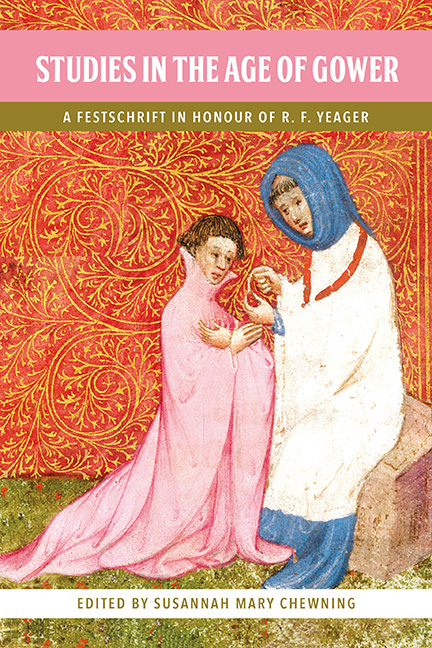Book contents
- Frontmatter
- Contents
- List of Illustrations
- Notes on Contributors
- Acknowledgements
- List of Abbreviations
- Introduction
- Part I Text
- Part II Gender
- Part III Time
- Part IV Spirit
- Part V Intersections
- A Personal Tribute to R.F. Yeager
- Bibliography of R.F. Yeager’s Writings
- General Bibliography
- Index
- Miscellaneous Endmatter
6 - John Gower and the Artists of M. 126
Published online by Cambridge University Press: 28 April 2020
- Frontmatter
- Contents
- List of Illustrations
- Notes on Contributors
- Acknowledgements
- List of Abbreviations
- Introduction
- Part I Text
- Part II Gender
- Part III Time
- Part IV Spirit
- Part V Intersections
- A Personal Tribute to R.F. Yeager
- Bibliography of R.F. Yeager’s Writings
- General Bibliography
- Index
- Miscellaneous Endmatter
Summary
WHEN PETER C. BRAEGER wrote “The Illustrations in New College MS. 266 for Gower's Conversion Tales” in 1988 (published in 1989), he focused mainly on the stories highlighted by several of the nineteen remaining pictures. Before it was vandalized, the manuscript had at least thirty-two illustrations. For Braeger, the images in New College MS. 266 served to guide “readers of the manuscript in the process of understanding individual exempla and Gower's poem as a whole.” On the other hand, the illuminations in Morgan M. 126, the only other Confessio Amantis manuscript with a full picture cycle, introduce nearly every story – there are 106 miniatures – but do not act precisely as guides to Gower's meaning. Rather, they perform alternative readings or elaborate imaginatively on the stories they introduce. The content of these images is often fanciful and sometimes quite graphic. I would further contend that these pictures are consciously used to highlight some of Gower's own oddities in the text and to focus the reader's attention on aspects of Gower that are sometimes otherwise overlooked; for example, Gower's absolute fearlessness in addressing subject matter (none of Chaucer's prim pussyfooting around the story of Canace, for example) and the surreal transformation, often drawn from Ovid and other sources, of certain of Gower's characters. These themes are all reflected or perhaps refracted in the illustrations. This essay considers several stories and their illustrations in M. 126, a manuscript copied some eighty years after Gower's composition of Confessio. I also discuss briefly the making of M. 126, its scribe and artists, and its connections with two other contemporary manuscripts copied by the same scribe.
As is well known, Geoffrey Chaucer's “Man of Law's Tale” opens with the Man of Law's complaint that all the best stories have been already told by Chaucer, though Chaucer avoids telling stories about incest like “thilke wikke ensample of Canacee, / That loved hir owene brother sinfully” (ll. 79–80) or the tale of incest involving Antiochus and his daughter.4 These two stories, of course, are told by Chaucer's friend “moral Gower” in Confessio Amantis (and these references in the Man of Law's Prologue seem to serve as a form of self-reflexivity if the Man of Law is seen as a projection of Gower talking about Chaucer, as Chaucer writes him).
- Type
- Chapter
- Information
- Studies in the Age of GowerA Festschrift in Honour of Robert F. Yeager, pp. 99 - 116Publisher: Boydell & BrewerPrint publication year: 2020



